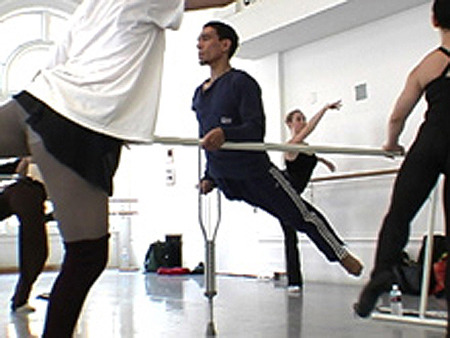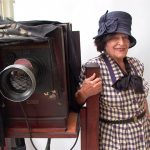The Business of Art: Bartering Art for Healthcare
Three years before his death, Homer Avila rehearses +Pas, a piece choreographed for him after his amputation, in this still from Karina Epperlein’s 16-minute documentary, Phoenix Dance (2006).
In 2001, after years of being unable to afford a doctor’s visit, world-renowned dancer and choreographer Homer Avila happily found himself with a gig at the Santa Fe Opera that provided the ever-elusive benefit of health insurance. Avila, who had long suffered from chronic hip pain, was finally able to see a doctor—and in the process learned that the source of his pain was a rare form of cancer, which had spread through his right leg and necessitated amputation. In 2004, Avila passed away at the age of 48, his life truncated simply because his choice of profession did not afford him health insurance.
Avila’s death was a tragic realization of a common nightmare for artists who are unable to afford health insurance or comprehensive medical care. It only adds insult to injury that those living on arts-industry wages rarely receive the same benefits and services that typically accompany more conventional occupations. Artists may be an infamously resourceful group, but health care opportunities are severely limited for those who are talent rich but cash poor.
Enter Artist Access, a fledgling program based out of Brooklyn’s Woodhull Medical and Mental Health Center that offers artists the opportunity to exchange cultural capital for comprehensive health care. The program was conceived in 2004 when dancer and arts administrator Laura Colby befriended Dr. Edward Fishkin, Woodhull’s medical director, through the New York Cycle Club. At one point Fishkin, who had noticed the number of artists and young people proliferating in Brooklyn, asked Colby what artists did for health insurance. “I just laughed,” says Colby. “And I said, ‘well—they don’t.’”
Colby shared Avila’s story with Fishkin, who was appalled—particularly because New York City hospitals offer a program called HHC Options, which offers health care on an income-based sliding scale. “I shared this story with Ed,” Colby says, “and he said ‘for crying out loud, he could have come in to any New York City hospital and had that diagnosed the minute he felt it.’”
Shortly after, the two gathered together a consortium of artist-service organizations—including Dance Theater Workshop, Dance/NYC, and the New York Foundation for the Arts—to discuss how best to bring health care opportunities to New York’s working artists. Colby says many in the initial meeting had known Avila personally, and that his death was both devastatingly painful and extremely motivating. Avila’s illness had already spurred NYFA to form One Step Forward, a fund for dancers faced with sudden debilitating injuries and other medical emergencies; in June of 2001, NYFA threw a benefit for Avila at St. Mark’s Church with performances by Twyla Tharp, John Jasperse, Mark Morris, and Bill T. Jones and Arnie Zane, among many others.
“Ed was determined to get the artists in,” Colby says, “and he said, why don’t we create Artist Access, so the artists feel welcomed, so they can speak to somebody who is cognizant of the pressure points.” Having a group of artists and arts professionals to help develop the program was essential, Colby says, “to speak as someone who had worked as an artist in New York City, and to point out a level of sensitivity that they needed.”
Artist Access works with artists of all disciplines, allowing them to swap site-specific art—in the form of performance, original work, or education programs—for health care credits. One hour of work earns an artist 40 credits, which translates to $40 earmarked for future medical fees incurred at Woodhull or Manhattan’s Bellevue Hospital Center (Bellevue does not run an Artist Access program of its own, but does accept credits from Woodhull). Artists can use credits to pay for diagnoses, prescriptions, and procedures. “For some artists it meant being able to have a teeth cleaning for the first time in ten years,” Colby says.
Sweetening the deal is the fact that Woodhull, as a public institution, already operates on a sliding scale system under New York City’s HHC Options program. This means that a few afternoons spent teaching drawing to children or painting a mural to complement the Keith Haring originals in the hospital’s entry halls can completely cover the cost of anything from a cavity to a colonoscopy. Fishkin recalls that the first patient to use Artist Access was a dancer with hip pain. On her first visit to Woodhull, the dancer saw an orthopedist and a gynecologist, had an MRI, a CAT scan, and an ultrasound—and was billed only twenty dollars.
Woodhull stands at the crossroads of Bushwick, Williamsburg, and Bedford Stuyvesant, neighborhoods that artists have flocked to in recent years in search of affordable rents and postindustrial lofts and workspaces. Artist Access is one way for hospital administrators to strengthen ties to the neighborhoods’ burgeoning arts communities while creating a livelier hospital environment for patients in recovery. Since the program’s inception in 2005, close to 700 artists have contributed their time, talents, and artwork to the hospital. Currently, about 200 more are contributing their skills and creativity.
Archie Lee Coates, a 26-year-old visual artist and designer, learned about Artist Access while researching an impending move to Brooklyn. “For someone my age who doesn’t have a history of illness, I just want health care to feel okay,” says Coates. “But the options for me are slim. I basically have to spend rent money times two in order to pay a doctor. [Artist Access] works well in the sense that I can walk in any time and just get checked up.”
During Coates’s last visit to Woodhull, he taught a group of listless children how to draw hot dogs. “It became a really empowering thing, where everyone wanted to draw something,” he says. For his next project he hopes to gather a team of children to collaborate on a mural. Long inspired by Haring, Coates found the murals at Woodhull particularly exciting. “You walk in and you can see Haring’s brush strokes,” he says. “[Haring] was making a direct pipeline to making people happier. I’d love to be able to contribute to that tradition.”
To qualify for the Artist Access program, individuals must prove that they are working artists and submit a work proposal describing how they will contribute to Woodhull. (Because many artists are paid erratically or under the table, the process is based on a simple one-page application that does not require a W-2 or other formal proof of income; similarly, self-identification as an artist is effectively based on good faith, and does not involve an audition or work samples.) Woodhull’s Creative Arts Department then reviews and evaluates proposals and works to find the best placement among departments such as the geriatric, pediatric, and rehabilitation units.
The program prefers interactive performances that directly engage hospitalized patients, but remains open-minded about accepting a range of creative contributions. Actors role-play as patients to help residents practice their bedside manner; dancers teach yoga classes; professional photographers take photographs of newborns in the maternity ward. One illustrator has set up a station in the lobby to make personalized get-well cards. Artists are invited to get creative with their contributions, from meditating with patients to holding art exhibits and staging large-scale dance and music performances in the hospital lobby. “The artists have brought a really beautiful goodwill and spirit into a place that is all about stress and pain and sometimes dying,” Colby says. “I think when the artists come into the room, that energy changes drastically.”
While the exchange program is only open to artists, Woodhull also offers affordable health care options to arts workers—from administrators to lighting designers—in the form of HHC Platinum, a financial assistance program that charges patients on a sliding scale. It should be noted that while Woodhull is the only hospital with a barter program, all New York City public hospitals offer the sliding scale payment system of HHC Options. All New York City residents who earn an annual income of up to 400% of the federal poverty level (about $36,000) can enroll in this plan provided they are uninsured and ineligible for Medicaid, Medicare, or other insurance programs offered by New York State.
Colby and Fishkin both acknowledge that there are certain stigmas that may prevent artists from visiting public hospitals. “I think one stigma was that [many artists] came from families that had health insurance; now that they’re without health insurance, a lot of them don’t want to feel they’re on the public dole,” Fishkin says. “But now they’re actually contributing to their health care. It’s very hard being a patient in an urban area. Hospitals are big, systems are cold and complicated. Artist Access just makes it a little more personal.”
Whether barter programs like Artist Access can be replicated across a broad access system remains to be seen. For one, administrations and resources vary greatly from one New York City public hospital to the next. Fishkin has given presentations to other hospitals and spoken to many others about Artist Access in the hopes that the program will inspire similar ones. Regardless of how receptive other institutions are to the art-for-healthcare idea, Fishkin is certain about one thing: “the artists would do it,” he says with confidence.
To learn more about Artist Access, artists should contact program coordinator Timothy McDonough at (718) 630-3069.
Anna Wiener is a Brooklyn-based writer and editor. She is a contributing writer for Next American City and Prefix Magazine, and is currently at work on a collection of short stories.





